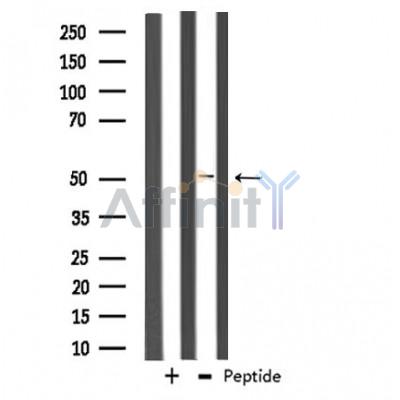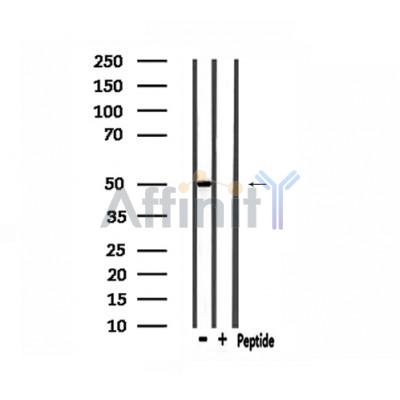ADCK3 Antibody - #DF3360
| Product: | ADCK3 Antibody |
| Catalog: | DF3360 |
| Description: | Rabbit polyclonal antibody to ADCK3 |
| Application: | WB IHC IF/ICC |
| Reactivity: | Human, Mouse, Rat |
| Prediction: | Pig, Zebrafish, Bovine, Horse, Sheep, Rabbit, Dog, Xenopus |
| Mol.Wt.: | 50 KD; 72kD(Calculated). |
| Uniprot: | Q8NI60 |
| RRID: | AB_2835576 |
Related Downloads
Protocols
Product Info
*The optimal dilutions should be determined by the end user. For optimal experimental results, antibody reuse is not recommended.
*Tips:
WB: For western blot detection of denatured protein samples. IHC: For immunohistochemical detection of paraffin sections (IHC-p) or frozen sections (IHC-f) of tissue samples. IF/ICC: For immunofluorescence detection of cell samples. ELISA(peptide): For ELISA detection of antigenic peptide.
Cite Format: Affinity Biosciences Cat# DF3360, RRID:AB_2835576.
Fold/Unfold
aarF domain containing protein kinase 3; aarF domain-containing protein kinase 3; ADCK 3; Adck3; ADCK3_HUMAN; ARCA2; CABC 1; CABC1; Chaperone ABC1 (activity of bc1 complex S.pombe) like; Chaperone ABC1 activity of bc1 complex homolog; Chaperone ABC1 like; Chaperone activity of bc1 complex like; Chaperone activity of bc1 complex like mitochondrial; Chaperone activity of bc1 complex-like; Chaperone-ABC1-like; Coenzyme Q8 homolog; COQ 8; COQ10D4; COQ8; COQ8, S. cerevisiae, homolog of; MGC4849; mitochondrial; OTTHUMP00000035734; OTTHUMP00000035737; SCAR9;
Immunogens
A synthesized peptide derived from human ADCK3, corresponding to a region within the internal amino acids.
Widely expressed, with highest levels in adrenal gland, heart, pancreas, nasal mucosa, stomach, uterus and skeletal muscle.
- Q8NI60 COQ8A_HUMAN:
- Protein BLAST With
- NCBI/
- ExPASy/
- Uniprot
MAAILGDTIMVAKGLVKLTQAAVETHLQHLGIGGELIMAARALQSTAVEQIGMFLGKVQGQDKHEEYFAENFGGPEGEFHFSVPHAAGASTDFSSASAPDQSAPPSLGHAHSEGPAPAYVASGPFREAGFPGQASSPLGRANGRLFANPRDSFSAMGFQRRFFHQDQSPVGGLTAEDIEKARQAKARPENKQHKQTLSEHARERKVPVTRIGRLANFGGLAVGLGFGALAEVAKKSLRSEDPSGKKAVLGSSPFLSEANAERIVRTLCKVRGAALKLGQMLSIQDDAFINPHLAKIFERVRQSADFMPLKQMMKTLNNDLGPNWRDKLEYFEERPFAAASIGQVHLARMKGGREVAMKIQYPGVAQSINSDVNNLMAVLNMSNMLPEGLFPEHLIDVLRRELALECDYQREAACARKFRDLLKGHPFFYVPEIVDELCSPHVLTTELVSGFPLDQAEGLSQEIRNEICYNILVLCLRELFEFHFMQTDPNWSNFFYDPQQHKVALLDFGATREYDRSFTDLYIQIIRAAADRDRETVRAKSIEMKFLTGYEVKVMEDAHLDAILILGEAFASDEPFDFGTQSTTEKIHNLIPVMLRHRLVPPPEETYSLHRKMGGSFLICSKLKARFPCKAMFEEAYSNYCKRQAQQ
Predictions
Score>80(red) has high confidence and is suggested to be used for WB detection. *The prediction model is mainly based on the alignment of immunogen sequences, the results are for reference only, not as the basis of quality assurance.
High(score>80) Medium(80>score>50) Low(score<50) No confidence
Research Backgrounds
Atypical kinase involved in the biosynthesis of coenzyme Q, also named ubiquinone, an essential lipid-soluble electron transporter for aerobic cellular respiration. Its substrate specificity is unclear: does not show any protein kinase activity. Probably acts as a small molecule kinase, possibly a lipid kinase that phosphorylates a prenyl lipid in the ubiquinone biosynthesis pathway, as suggested by its ability to bind coenzyme Q lipid intermediates. Shows an unusual selectivity for binding ADP over ATP.
Mitochondrion. Membrane>Single-pass membrane protein.
Widely expressed, with highest levels in adrenal gland, heart, pancreas, nasal mucosa, stomach, uterus and skeletal muscle.
Adopts an atypical protein kinase-like fold: while it adopts a core fold similar to that of well-characterized protein kinase-like domains, a number of features are positioned to inhibit the kinase activity: (1) an atypical AAAS motif in an alanine-rich (A-rich) loop that replaces the canonical glycine-rich (G-rich) nucleotide-binding loop and limits ATP binding by establishing an unusual selectivity for ADP and (2) an N-terminal domain, containing the KxGQ motif, that completely occludes the typical substrate binding pocket (PubMed:25498144). Nucleotide-binding opens the substrate binding pocket and flips the active site from inside the hydrophobic core into a catalytically competent, solvent-exposed posture (PubMed:27499294).
Belongs to the protein kinase superfamily. ADCK protein kinase family.
Restrictive clause
Affinity Biosciences tests all products strictly. Citations are provided as a resource for additional applications that have not been validated by Affinity Biosciences. Please choose the appropriate format for each application and consult Materials and Methods sections for additional details about the use of any product in these publications.
For Research Use Only.
Not for use in diagnostic or therapeutic procedures. Not for resale. Not for distribution without written consent. Affinity Biosciences will not be held responsible for patent infringement or other violations that may occur with the use of our products. Affinity Biosciences, Affinity Biosciences Logo and all other trademarks are the property of Affinity Biosciences LTD.




